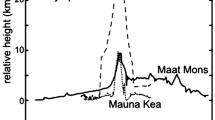Abstract
A simple procedure for estimating the fraction of the mantle response that is actually isostatic is used here with four carbonate buildups to provide variations of the isostatic fraction along the buildups. In all cases it is found that the fraction is small compared to that needed to allow isostasy to be the dominant component. Tectonic variations, sea-level effects, and compaction of underlying substrates after carbonate deposition all contribute to the non-isostatic response. In addition, the relative variation of the equivalent isostatic factor along each carbonate buildup is shown to be a direct consequence of changes in tectonism, sea-level and/or compaction with lateral position. These identifications are made through use of the general geologic description of the region for each buildup. The isostatic factor method is thus shown to provide a simple and powerful procedure for identifying not only the over-all non-isostatic response but also variations of the non-isostatic factors along the buildups.
Similar content being viewed by others
References
DREES, N.C.M., 1988, The Middle Devonian Sub-Watt Mountain Unconformity Across the Tathlina Uplift; District of Mackenzie and Northern Alberta, Canada, in Devonian of the World (eds. N.J. McMillan, A.F. Embry and D.J. Glass).Can. Soc. Petrol. Geol., Calgary, Canada, p. 477–494.
FLÜGEL, E, and FLÜGEL-KAHLER, E., 1992, Phanerozoic Reef Evolution:Basic Questions and Data Base, in Facies 26, p. 167–278.
JAMES, N.P., 1983, in P.A. Scholle, D.G. Bebout, and C.H. Moore, eds., Carbonate depositional environments:American Association of Petroleum Geologists Memoir 33, p. 345–444.
LERCHE, I. and PERLMUTTER, M.A., 1993, Fractional isostatic mantle compensation of carbonate buildups.American Association of Petroleum Geologists, Bulletin, v. 77, p. 276–279.
RUDOLPH, K.W. and LEHMANN, P.J., 1989, Platform Evolution and Sequence Stratigraphy of the Natuna Platform, South China Sea, in Controls on Carbonate Platform and Basin Development,SEPM Special Publication No. 44, p. 353–361.
SCHLAGER, W., 1981, The paradox of drowned reefs and carbonate platforms:Geological Society of America Bulletin, v. 92, p. 197–211.
SIMO, A., 1989, Upper Cretaceous Platform-to-Basin Depositional-Sequence Development, Tremp Basin, South-central Pyrennes, Spain, in Controls on Carbonate Platforms and Basin Development,SEPM Special Publication No. 44, p. 365–378.
SMITH, D.B., 1981, The Magnesian Limestone (Upper Permian) Reef Complex of Northeastern England,SEPM Special Publication No. 30, p. 161–186.
WERMUND, E.G., 1975, Upper Pennsylvanian limestone banks, north central Texas:University of Texas Bureau of Economic Geology, Circular 75–3.
Author information
Authors and Affiliations
Rights and permissions
About this article
Cite this article
Perlmutter, M.A., Lerche, I. Case histories of isostatic factor variations along carbonate buildups. Carbonates Evaporites 9, 89–94 (1994). https://doi.org/10.1007/BF03175188
Received:
Accepted:
Published:
Issue Date:
DOI: https://doi.org/10.1007/BF03175188




